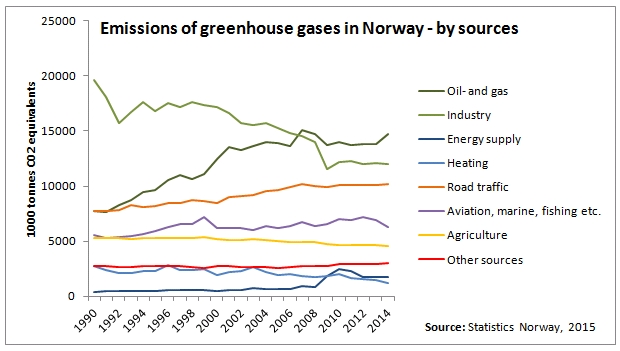Great potential for reducing methane emissions – in Norway and globally
Biogas represents a large and untapped potential to reduce emissions from waste and transportation. Positive development requires interaction between many sectors.
The climate debate is evolving and now has a growing focus on methane emissions. Methane is more potent than CO₂, and whether the emissions are man-made or natural, they will result in a higher need to cut other climate gases if they continue and increase in the future. In Norway today, most methane emissions come from agriculture and waste. This natural methane can be made into biogas and replace oil products in transportation, reducing emissions twice. Globally, there are large deposits of methane hydrates which could melt if the world warms. This has already started and containing this source of emissions could give a large contribution to reducing the overall climate gases in the atmosphere. Norway has skills in hydrocarbon extraction and could contribute here.
 Artikkelen er hentet fra rapporten «Slik kan Norge gjøre en forskjell», gitt ut av Norsk Klimastiftelse i juni 2015. Se flere artikler fra rapporten.
Artikkelen er hentet fra rapporten «Slik kan Norge gjøre en forskjell», gitt ut av Norsk Klimastiftelse i juni 2015. Se flere artikler fra rapporten.This article covers two sources of Norwegian emissions: Methane from waste and agriculture as well as emissions from transport. These two sectors, if combined, have larger emissions than the oil industry, but get less attention, even if solutions could be quicker and economic. If we look at the full picture, we could let one problem solve another problem – reducing methane emissions as well as CO₂ and other emissions from the transport sector. This requires a desire to have cleaner air and lower climate emissions, as well as thinking outside the traditional boxes or silos.
According to IPCC, methane is 34 times stronger as a heat-trapping gas than CO₂ over a 100-year time-scale, while over a 20-year period, methane has a global warming potential of 86-105 compared to C02. Much of methane emissions in Norway come from agriculture and waste (see figure 1), and this can be utilised and replace oil products.

The transport sector is responsible for about one third of the total emissions of GHG in Norway, and emissions have been growing steadily since 1990 (see figure 2).

If biogas is used in cars, replacing petrol or diesel, the net impact is climate negative! (see figure 3). Biogas has a positive local environmental effect as well, because it reduces the emissions of both particular matter, sulphur oxides (Sox) and nitrogen dioxide (NOx), and reduces noise. In addition, it could bring income to local communities with agriculture and fish industry. One of the main advantages of biogas production is the ability to transform waste material into a valuable resource. Many European countries, including Norway, are facing large problems associated with emissions from organic wastes from industry, agriculture and households. Production of biogas from waste of various kinds is an effective approach to waste management.

Several solutions are available, such as electric cars and biodiesel. However, if biogas is used, it reduces more emissions nationally! Norway has started in Oslo, Drammen and Stavanger, for example. This is a start, but there is a large, untapped potential to reduce emissions from waste and transportation. Gas is used as a transport fuel in many countries, and even more so in some countries outside Europe. The technology is fully developed and cars are available, and we could learn from Sweden, Germany and Switzerland.
In the last few years there has been more interest in using biogas in Norway, and the Norwegian government presented a national sector-spanning biogas strategy in October 2014. The strategy claims that the usage of biogas will contribute to national reduction of emissions by 2020 and to the objective that Norway will be a low-emission society in 2050. A considerable technical potential for production and use of biogas has been identified, also in the transport sector, and several instruments are proposed to stimulate technology development and reduce cost. In the revised national budget for 2015, the Government proposes to allocate NOK 20 million to support more use of biogas in buses. Despite some initiatives, both production and use of biogas in Norway is very low, both when comparing Norway with other countries, and when comparing biogas with other energy sources. What is produced is used for heating or fuel, but more raw material for biogas is exported to Denmark and Sweden.
If biogas has such a great potential, why is it not growing faster?
The development of new technology is reliant on interaction between many sectors, but silo-mentality reduces innovation and could contribute to valuable opportunities being missed. Increasingly effort should be given to facilitate more cooperation across different sectors (waste, transport, fish processing etc). Such cooperation would contribute to more synergies and to exchange of experiences throughout the full value chain of biogas – from raw materials to consumption.
Electric vehicles have by many politicians been seen as an important contributor to a greener transport sector in Norway, and in April, electric vehicle No. 50,000 rolled onto Norwegian roads. It would be wise to think about more than one solution, even though this requires more effort from politicians. Some attention is also given to biodiesel and ethanol. This might well be good for the forest industry, but we see that it could also extend the life of diesel use and requires high investments in uncertain conditions. There is also a growing need to look at the overall sustainability of ethanol, regarding competition with food as well as use of water.
It is easier to introduce biogas in markets that use natural gas already. However it is not a requirement, and the value of reduced emissions, both at home and in other countries should be considered in a full picture perspective. A too fast introduction of the proposed road-use tax on gas in Norway will probably weaken the use of biogas and therefore have a negative impact on greenhouse gas emissions in Norway. Norsk Petroleumsinstitutt argues for a delayed and stepwise introduction to encourage to new investments and take care of investments already done in vehicles and infrastructure.
Biogas will not be the only solution, not even within the transport sector, but it could be a part of the solution – just as electric cars. The initiative to move Transnova’s tasks to Enova could be a first step towards better coordination and a more comprehensive evaluation of potential projects.
To enable a shift, clear policy objectives and instruments are needed. We need to want to act! This also means that politicians need to take action, even if it is unpopular at times.
Global challenge: Methane hydrates melting
The amount of methane in hydrate form (ice-bound lattice structure) today is estimated to be many times the global natural gas reserves but developing these deposits remains expensive. There is also a critical environmental value in avoiding anthropocentrically caused melting of hydrates which would result in elevated methane emissions.
Last summer, a small deposit in Siberia melted, causing a crater in the ground and emissions of methane to the atmosphere. Methane hydrates are found in many places in the world including offshore Norway. There has been some focus on developing land based (sub-permafrost) methane hydrate deposits for natural gas production, mainly in northern Alaska, the Yukon and in Russia. Japan has committed extensive R&D efforts in the offshore environment and will be testing production of natural gas from methane hydrates over the next 2-3 years. Korea and India are also pursuing offshore research.
A key point to consider is that despite the potential attraction of methane hydrates as an energy source, it is critical to assess the climate consequences of potential energy development including the possible acceleration of hydrate melting, especially in the North, where climate change will increase temperatures more than the global average. Hydrate research may also discover new ways to store CO₂ – which could be useful in a world needing to mitigate the effects of emissions from fossil fuels while actively transitioning to no carbon economies.
This is just a short brief considering how big a topic this is. However we wanted to highlight this issue, as the destabilizing of methane hydrates could be a potentially large source of potent climate gases. A Norwegian contribution on this matter, considering the available national expertise, could be significant!
